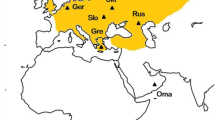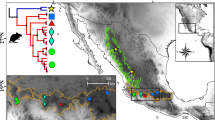Abstract
DNA sequence analysis of a 215 base-pair region of the mitochondrial cytochrome b gene was used to examine genetic variation and search for evidence of an increased mutation rate in black-crowned night-herons. We examined five populations exposed to environmental contamination (primarily PAHs and PCBs) and one reference population from the eastern U.S. There was no evidence of a high mutation rate even within populations previously shown to exhibit increased variation in DNA content among somatic cells as a result of petroleum exposure. Three haplotypes were observed among 99 individuals. The low level of variability could be evidence for a genetic bottleneck, or that cytochrome b is too conservative for use in population genetic studies of this species. With the exception of one population from Louisiana, pair-wise Phist estimates were very low, indicative of little population structure and potentially high rates of effective migration among populations.
Similar content being viewed by others
References
Anderson, S., Sadinski, W., Shugart, L., Brussard, P., Depledge, M., Ford, T., Hose, J., Stegeman, J., Suk, W., Wirgin, I. and Wogan, G. (1994). Genetic and molecular ecotoxicology: a research framework. Environ. Health Perspect. 102(Suppl. 12), 3–8.
Baker, R.J., Van Den Bussche, R.A., Wright, A.J., Wiggins, L.E., Hamilton, M.J., Reat, E.P., Smith, M.H., Lomakin, M.D. and Chesser, R.K. (1996). High levels of genetic change in rodents of Chernobyl. Nature 380, 707–8.
Baker, R.J., Van Den Bussche, R.A., Wright, A.J., Wiggins, L.E., Hamilton, M.J., Reat, E.P., Smith, M.H., Lomakin, M.D. and Chesser, R.K. (1997). High levels of genetic change in rodents of Chernobyl (Retraction of Vol. 380, pp. 707, 1996). Nature 390, 100.
Bickham, J.W., Mazet, J.A., Blake, J., Smolen, M.J., Lou, Y. and Ballachey, B.E. (1998). Flow-cytometric determination of genotoxic effects of exposure to petroleum in mink and sea otters. Ecotoxicology 7, 191–9.
Bickham, J.W., Sandhu, S.S., Hebert, P.D.N., Chikhi, L. and Anthwal, R. (2000). Effects of chemical contaminants on genetic diversity in natural populations: implications for biomonitoring and ecotoxicology. Mutat. Res. 463, 33–51.
Bickham, J.W. and Smolen, M.J. (1994). Somatic and heritable effects of environmental genotoxins and the emergence of evolutionary toxicology. Environ. Health Perspect. 102(Suppl. 12), 25–8.
Blus, L.J., Neely, B.S. Jr., Lamont, T.G. and Mulhern, B. (1977). Residues of organochlorines and heavy metals in tissues and eggs of brown pelicans 1969–73. Pesticides Monitoring J. 11, 40–53.
Carr, S.M. and Marshall, H.D. (1991). A direct approach to the measurement of genetic variation in fish populations: applications of the polymerase chain reaction to the study of Atlantic cod, Gadus morhua L. J. of Fish Biol. 39(Suppl. A), 101–7.
Cronin, M.A. and Bickham, J.W. (1998). A population genetic analysis of the potential for a crude oil spill to induce heritable mutations and impact natural populations. Ecotoxicology 7, 259–78.
Custer, T.W., Bickham, J.W., Lyne, T.B., Lewis, T., Ruedas, L.A., Custer, C.M. and Melancon, M.J. (1994). Flow cytometry for monitoring contaminant exposure in Black-crowned Night-Herons. Arch. Environ. Contam. Toxicol. 27, 176–9.
Custer, T.W., Custer, C.M., Hines, R.H., Sparks, D.W., Melancon, M.J., Hoffman, D.J., Bickham, J.W., and Wickliffe, J.K. (2000). Mixed-function oxygenases, oxidative stress, and chromosomal damage in lesser scaup wintering on the Indiana Harbor Canal. Arch. Environ. Contam. Toxicol. 38, 522–9.
Custer, T.W., Rattner, B.A., Ohlendorf, H.M. and Melancon, M. (1991). Herons and egrets as proposed indicators of estuarine contamination in the United States. Acta Congressus Internationalis Ornithologici 20, 2474–9.
Deiter, M.P. (1993). Identification and quantification of pollutants that have the potential to affect evolutionary processes. Environ. Health Perspect. 101, 278.
Depledge, M. (1994). Genotypic toxicity: Implications for individuals and populations. Environ. Health Perspect. 102(Suppl. 12), 101–4.
Dhar, A.K., Pokras, M.A., Garcia, D.K., Evers, D.C., Gordon, Z.J. and Alcivar-Warren, A. (1997). An analysis of genetic diversity in common loon Gavia immer using RAPD and mitochondrial RFLP techniques. Mol. Ecol. 6, 581–86.
Djomo, J.E., Ferrier, V., Gauthier, L., Zoll-Moreux C. and Marty, J. (1995). Amphibian micronucleus test in vivo: evaluation of the genotoxicity of some major polycyclic aromatic hydrocarbons found in crude oil. Mutagenesis 10, 223–6.
Ellegren, H., Lindgren, G., Primmer, C.R. and Moller, A.P. (1997). Fitness loss and germline mutations in barn swallows breeding in Chernobyl. Nature 389, 593–6.
Ellsworth, D.L., Honeycutt, R.L., Silvy, N.J., Rittenhouse, K.D. and Smith, M.H. (1994). Mitochondrial DNA and nuclear gene differentiation in North American prairie grouse (Genus Tympanuchus). Auk 111, 661–71.
Erwin, R.M., Haig, J.G., Stotts, D.B. and Hatfield, J.S. (1996). Reproductive success, growth and survival of Black-crowned Night-Heron (Nycticorax nycticorax) and snowy egret (Egretta thula) chicks in coastal Virginia. Auk 113, 119–30.
Excoffier, L., Smouse, P.E. and Quattro, J.M. (1992). Analysis of molecular variation inferred from metric distances among DNA haplotypes: applications to human mitochondrial DNA restriction data. Genetics 131, 479–91.
Ferl, R.J., Narin, C.J., She, J., Wakeland, E. and Almira, E. (1991). The application of automated DNA sequence analysis phylogenetic studies. In M.M. Miyamoto and J. Cracraft (eds) Phylogenetic Analysis of DNA Sequences, pp. 45–58. New York: Oxford University Press.
Fox, G.A. (1995). Tinkering with the tinkerer: pollution versus evolution. Environ. Health Perspect. 103(Suppl. 4), 93–100.
Guttman, S.I. (1994). Population genetic structure and ecotoxicology. Environ. Health Perspect. 102(Suppl. 12), 97–100.
Hebert, P.D.N. and Luiker, M.M. (1996). Genetic effects of contaminant exposure—towards an assessment of impacts on animal populations. Sci. Total Environ. 191. 23–58.
Kocher, T.D., Thomas, W.K., Meyers, A., Edwards, S.V., Paabo, S., Villablanca, F.X. and Wilson, A.C. (1989). Dynamics of mitochondrial DNA evolution in animals: Amplification and sequencing with conserved primers. Proc. Natl Acad. Sci., USA 86, 6196–200.
Maniatis, T., Fritsch, E.F. and Sambrook, J. (1982). Molecular Cloning: A Lab Manual. Cold Spring Harbor Laboratory, New York.
Matsuoka, A.K., Shudo, Y., Saito, Y., Sofuni, T. and Ishidate, Jr. M. (1982). Clastogenic potential of heavy oil extracts and some aza-arenes in Chinese hamster cells in culture. Mutat. Res. 102, 275–83.
McElroy, D., Moran, P., Bermingham, E. and Kornfield, I. (1992). REAP: An integrated environment for the manipulation and phylogenetic analysis of restriction data. J. Heredity 83, 157–8.
Murdoch, M.H. and Hebert, P.D.N. (1994). Mitochondrial DNA diversity in brown bullhead from contaminated and relatively pristine sites in the Great Lakes. Environ. Toxicol. Chem. 13, 1281–9.
Newman, M.C. and Jagoe, R.H. (1998). Allozymes reflect the population-level effect of mercury: simulations of the mosquitofish (Gambusia holbrooki Girard) GPI-2 response. Ecotoxicology 7, 141–50.
Roff, D.A. and Bentzen, P. (1989). The statistical analysis of mitochondrial DNA polymorphisms: χ2 and the problem of small samples. J. Heredity 83, 157–8.
Sheldon, F.H., Jones, C.E. and McCracken, K.H. (2000). Relative patterns and rates of evolution in heron nuclear and mitochondrial DNA. Mol. Biol. Evol. 17, 437–50.
Theodorakis, C.W., Bickham, J.W., Elbl, T., Shugart, L.R. and Chesser, R.K. (1998). Genetics of radionuclide-contaminated mosquitofish populations and homology between Gambusia affinis and G. holbrooki. Environ. Toxicol. Chem. 17, 1992–8.
Theodorakis, C.W. and Shugart, L.R. (1997). Genetic ecotoxicology II: Population genetic structure in mosquitofish exposed in situ to radionuclides. Ecotoxicology 6, 335–54.
Weir, B.S. and Cockerham, C.C. (1984). Estimating F-statistics for the analysis of population structure. Evolution 38, 1358–70.
Rights and permissions
About this article
Cite this article
Dahl, C.R. Cytochrome b Sequences in Black-Crowned Night-Herons (Nycticorax nycticorax) from Heronries Exposed to Genotoxic Contaminants. Ecotoxicology 10, 291–297 (2001). https://doi.org/10.1023/A:1016711401809
Issue Date:
DOI: https://doi.org/10.1023/A:1016711401809




